
CRITICAL CARE CLINICS
Scope & Guideline
Transforming Critical Care Through Evidence-Based Practices
Introduction
Aims and Scopes
- Health Disparities and Social Determinants:
The journal emphasizes the examination of health disparities related to race, ethnicity, gender, and socioeconomic status, particularly in the context of critical illness. It explores how these factors influence access to care and treatment outcomes. - Innovative Critical Care Practices:
There is a strong focus on innovative practices in critical care, such as telecritical care, early warning systems, and advanced monitoring techniques, aimed at improving the delivery of care and patient safety. - Artificial Intelligence and Data Science:
The journal explores the integration of artificial intelligence and data science in critical care, assessing their roles in predictive modeling, clinical decision-making, and enhancing patient management. - Comprehensive Management of Acute Conditions:
Critical Care Clinics covers a wide range of acute conditions, including respiratory failure, sepsis, and cardiac emergencies, providing insights into their diagnosis, management, and the latest therapeutic strategies. - Interdisciplinary Collaboration:
The journal highlights the importance of interdisciplinary collaboration in critical care settings, integrating perspectives from various healthcare professionals to enhance patient care.
Trending and Emerging
- Health Equity and Social Justice in Critical Care:
There is a rising trend in addressing health equity and social justice, with a focus on disparities in care among different demographic groups. This theme is increasingly relevant as healthcare systems strive for inclusivity and improved patient outcomes. - Integration of Technology in Critical Care:
Emerging themes include the integration of technology such as telemedicine and advanced monitoring systems, which are becoming crucial in delivering care in both hospital and prehospital settings. - Artificial Intelligence and Machine Learning Applications:
The application of AI and machine learning in critical care is gaining momentum, with research exploring their potential to enhance clinical decision-making and patient monitoring. - Palliative Care and Ethical Considerations:
There is an increasing focus on palliative care and ethical considerations in managing critically ill patients, especially in complex cases involving end-of-life decisions. - Resilience and Recovery in Critical Care:
Research is emerging around the concepts of resilience and recovery, particularly in how critically ill patients can regain function and quality of life after intensive care.
Declining or Waning
- Traditional Mechanical Ventilation Techniques:
There has been a noticeable decrease in the publication of papers solely focused on traditional mechanical ventilation techniques. This may reflect a shift towards more innovative approaches and technologies in respiratory management. - Basic Pharmacologic Treatments:
Papers concentrating on standard pharmacologic treatments for critical conditions are less frequent, indicating a potential transition towards more complex and tailored therapeutic strategies. - Historical Perspectives on Critical Care:
Research focused on historical perspectives or traditional practices in critical care has diminished, suggesting a growing interest in contemporary issues and future directions rather than retrospective analyses. - General Critical Care Protocols:
There is a decline in articles discussing generic critical care protocols, possibly due to the increasing focus on personalized medicine and patient-centered approaches that consider individual patient needs.
Similar Journals

Critical Care and Resuscitation
Exploring breakthroughs in critical care for improved patient lives.Critical Care and Resuscitation is a premier peer-reviewed journal published by Elsevier, focusing on the dynamic fields of Anesthesiology, Critical Care, and Emergency Medicine. Established in Australia, this journal has been a significant contributor to scholarly research since its inception in 1999, maintaining a strong reputation with a commendable impact factor, evidenced by its Q1 quartile rankings across its relevant categories for 2023. The journal's commitment to disseminating high-quality research is reflected in its elite standings: it ranks #7 out of 109 in Emergency Medicine, #12 out of 136 in Anesthesiology, and #16 out of 110 in Critical Care. Aimed at researchers, clinicians, and healthcare professionals, Critical Care and Resuscitation provides a vital platform for the latest advancements in patient care and clinical strategies, making it an essential resource for those eager to stay at the forefront of these critical disciplines. Although lacking Open Access options, its rigorous peer-review process ensures the publication of valuable insights that shape current practices and influence future developments in healthcare.
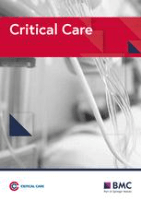
CRITICAL CARE
Transforming critical care with cutting-edge discoveries.CRITICAL CARE is an esteemed peer-reviewed journal dedicated to advancing the field of critical care and intensive medicine, published by BMC. Since its inception in 1998, it has been a prominent open-access platform that allows for the dissemination of high-quality research, fostering collaboration among researchers, healthcare professionals, and students globally. With a notable impact factor and ranking in the top quartile (Q1) of critical care and intensive care medicine, CRITICAL CARE occupies a vital role in disseminating cutting-edge findings and innovative practices that can significantly enhance patient outcomes in critical care settings. The journal not only encourages submissions of original research, clinical trials, and reviews but also emphasizes the importance of interdisciplinary approaches to critical care management. Positioned in the United Kingdom, CRITICAL CARE's commitment to open access ensures that its valuable content is readily available to a worldwide audience, reflecting its mission to bridge knowledge gaps and empower professionals in the pursuit of excellence in critical healthcare.

ANASTHESIOLOGIE & INTENSIVMEDIZIN
Advancing Anesthesia and Intensive Care KnowledgeANASTHESIOLOGIE & INTENSIVMEDIZIN is a peer-reviewed journal dedicated to the fields of anesthesiology, critical care, and intensive medicine. Published by AKTIV DRUCK & VERLAG GMBH in Germany, this journal has been an essential resource in the medical community since its inception in 1978. With a current impact factor placing it in the Q3 quartile in both anesthesiology and critical care categories, it serves as a platform for disseminating cutting-edge research and innovative practices. The journal invites contributions that enhance the understanding of pain management, perioperative care, and intensive treatment methodologies. Although not open access, it remains committed to advancing knowledge and improving patient outcomes. With a strong focus on practical applications, ANASTHESIOLOGIE & INTENSIVMEDIZIN is invaluable for researchers, clinical practitioners, and students seeking to deepen their expertise in these crucial areas of healthcare.
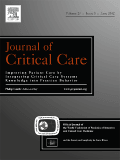
JOURNAL OF CRITICAL CARE
Elevating Standards in Intensive Care MedicineJOURNAL OF CRITICAL CARE, published by W B SAUNDERS CO-ELSEVIER INC, is a prestigious peer-reviewed journal in the field of critical care and intensive care medicine. With an impressive Q1 classification in 2023, it stands as a leading publication among its peers, ranking #12 out of 110 in the Scopus database, which places it in the 89th percentile of critical care-related journals. Established in 1986 and with a converged timeline extending to 2025, the journal serves as a critical resource for international researchers, healthcare professionals, and students dedicated to advancing practices and understanding within the realm of critical care. Although it does not offer Open Access, the journal provides high-quality, rigorously reviewed articles that address contemporary issues, innovative techniques, and groundbreaking research in critical care medicine. By fostering scholarly dialogue and disseminating new knowledge, the JOURNAL OF CRITICAL CARE is pivotal in shaping the future of intensive patient care and enhancing health outcomes.
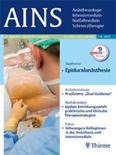
ANASTHESIOLOGIE INTENSIVMEDIZIN NOTFALLMEDIZIN SCHMERZTHERAPIE
Transforming Patient Care through Scholarly ExchangeANASTHESIOLOGIE INTENSIVMEDIZIN NOTFALLMEDIZIN SCHMERZTHERAPIE, published by GEORG THIEME VERLAG KG in Germany, serves as an essential resource for professionals in the fields of anesthesiology, intensive care, emergency medicine, and pain management. This esteemed journal, with the ISSN 0939-2661 and E-ISSN 1439-1074, has been a critical platform for scholarly exchange since 1980, advancing knowledge and practice in these vital areas of medicine. Although currently positioned in the Q4 category across several medical disciplines, its commitment to disseminating innovative research and case studies ensures that it remains relevant in the ever-evolving landscape of medical science. Although the journal does not offer open access, it provides comprehensive insights and findings that cater directly to the interests of researchers, clinicians, and students eager to enhance their expertise and stay abreast of contemporary practices. The journal continues to foster dialogue and development within its community, making a significant contribution to the understanding and improvement of patient care and clinical outcomes.

Canadian Journal of Respiratory Critical Care and Sleep Medicine
Pioneering research in respiratory health and intensive care.Welcome to the Canadian Journal of Respiratory Critical Care and Sleep Medicine, a prestigious peer-reviewed journal published by Taylor & Francis Inc. With an ISSN of 2474-5332 and an E-ISSN of 2474-5340, this journal serves as a vital platform for disseminating cutting-edge research in the fields of critical care, intensive care medicine, and pulmonary and respiratory medicine. Since its inception in 2017, the journal has established itself within the academic community, currently holding a Q2 ranking in Critical Care and Intensive Care Medicine and a Q3 ranking in Pulmonary and Respiratory Medicine for 2023. Although it operates under a standard access model, the journal remains committed to providing valuable insights and advancing knowledge through rigorous research articles, reviews, and case studies. Positioned in the heart of the United States, the journal aims to foster collaboration and innovation among healthcare professionals, researchers, and students dedicated to enhancing respiratory care and critical treatment protocols. Join us in exploring the dynamic intersection of research and practice that defines our mission.

PERFUSION-UK
Pioneering Research in Perfusion Science and Clinical ExcellencePERFUSION-UK is a distinguished academic journal published by SAGE Publications Ltd, focusing on advanced topics in the fields of nursing, cardiology, and radiology, among others. With an ISSN of 0267-6591 and an E-ISSN of 1477-111X, this journal serves as a crucial platform for disseminating vital research and innovative practices in both theoretical and applied aspects of perfusion science. Operating from the United Kingdom, it has an impressive history, converging years from 1986 to 2024. In the 2023 category quartiles, it has secured a Q2 ranking in Advanced and Specialized Nursing, revealing its strong reputation in the nursing community, while also ranking Q3 in cardiology and other medical specialties, which highlights its multidisciplinary significance. With a commendable Scopus ranking positioning it favorably among its peers, PERFUSION-UK is committed to providing researchers, professionals, and students access to cutting-edge studies and practices, ultimately aiming to enhance patient care and safety in clinical settings.
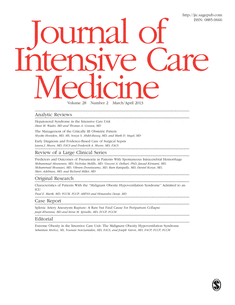
JOURNAL OF INTENSIVE CARE MEDICINE
Empowering Professionals with Cutting-Edge ResearchJOURNAL OF INTENSIVE CARE MEDICINE, published by SAGE PUBLICATIONS INC, is a leading peer-reviewed journal dedicated to advancing the field of critical care and intensive medicine. With an ISSN of 0885-0666 and an E-ISSN of 1525-1489, this esteemed journal showcases innovative research, clinical practices, and synthesis of knowledge that informs the complexities of patient care in intensive settings. Recognized for its exceptional impact, it holds a prestigious Q1 ranking in the Critical Care and Intensive Care Medicine category, landing in the upper 15% of its field according to Scopus rankings. Celebrating over three decades of publication since its inception in 1986, the journal serves both as a resource for seasoned professionals and a platform for emerging researchers eager to contribute to evidence-based practice. Although not open access, the journal ensures that critical insights and advancements are accessible to a broad audience, fostering a collaborative environment that is essential for the evolution of intensive care protocols and the enhancement of patient outcomes. With its commitment to excellence, the JOURNAL OF INTENSIVE CARE MEDICINE stands out as an invaluable resource that continues to shape the future of healthcare in critical domains.

Netherlands Journal of Critical Care
Pioneering Insights for Better Patient CareThe Netherlands Journal of Critical Care, an esteemed publication of the NETHERLANDS SOC INTENSIVE CARE, serves as a vital resource for those in the fields of critical care and intensive medicine. As a platform focused on disseminating high-quality research from 2008 to 2023, this journal provides critical insights and advancements pertinent to the rapidly evolving landscape of intensive care practices. Though categorized in the fourth quartile for Critical Care and Intensive Care Medicine in 2023, its commitment to enhancing patient outcomes remains unwavering. With an ISSN of 1569-3511, this journal invites submissions that push the boundaries of knowledge and offer innovative approaches to critical care challenges. Thus, it is an essential reference for researchers, healthcare professionals, and students eager to stay at the forefront of critical care developments in the Netherlands and beyond.
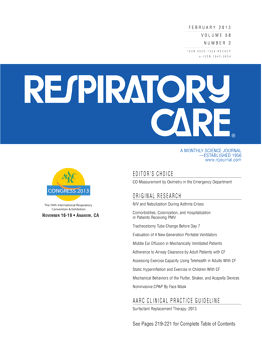
Respiratory Care
Shaping the Landscape of Critical Care Medicine.Respiratory Care is a leading journal in the fields of Critical Care, Intensive Care Medicine, and Pulmonary and Respiratory Medicine, published by DAEDALUS ENTERPRISES INC. With a history dating back to 1973 and continuing through 2024, this journal serves as a vital platform for disseminating innovative research findings, clinical practices, and advancements in respiratory healthcare. The journal is recognized for its impact, reflected in its impressive Q2 quartile rankings across several categories in 2023, demonstrating its relevance and influence in the medical community. Although it is not an Open Access publication, it provides critical insights and foster discussions aimed at enhancing patient care and treatment protocols for respiratory diseases. The journal is indexed in notable databases, ensuring wide visibility and accessibility of its content to researchers, professionals, and students dedicated to advancing knowledge and practice in respiratory care.